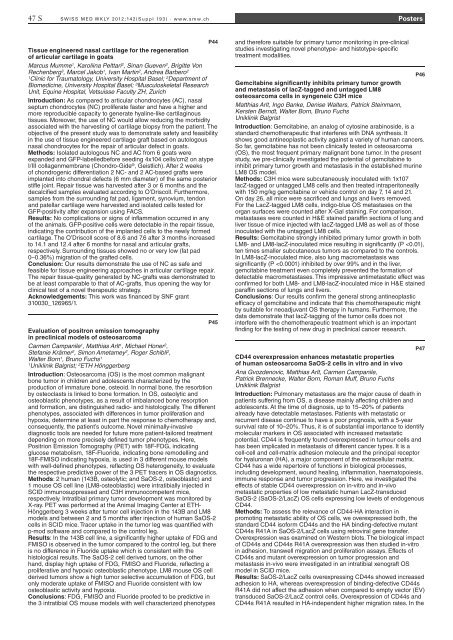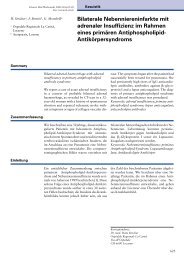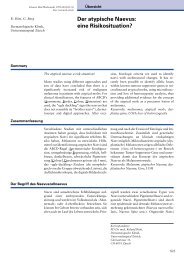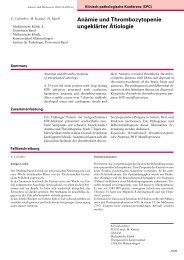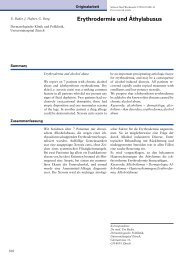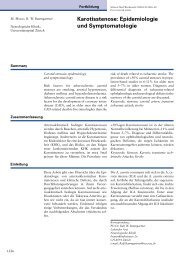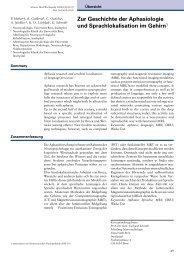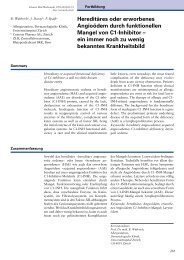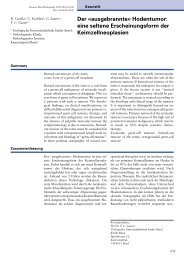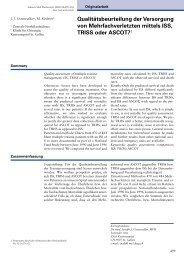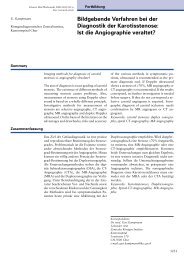SMW Supplementum 193 - Swiss Medical Weekly
SMW Supplementum 193 - Swiss Medical Weekly
SMW Supplementum 193 - Swiss Medical Weekly
Create successful ePaper yourself
Turn your PDF publications into a flip-book with our unique Google optimized e-Paper software.
47 S SWiSS Med Wkly 2012;142(Suppl <strong>193</strong>) · www.smw.ch Posters<br />
P44<br />
Tissue engineered nasal cartilage for the regeneration<br />
of articular cartilage in goats<br />
Marcus Mumme1 , Karoliina Pelttari2 , Sinan Gueven2 , Brigitte Von<br />
Rechenberg3 , Marcel Jakob1 , Ivan Martin2 , Andrea Barbero2 1 2 Clinic for Traumatology, University Hospital Basel; Department of<br />
Biomedicine, University Hospital Basel; 3Musculoskeletal Research<br />
Unit, Equine Hospital, Vetsuisse Faculty ZH, Zurich<br />
Introduction: As compared to articular chondrocytes (AC), nasal<br />
septum chondrocytes (NC) proliferate faster and have a higher and<br />
more reproducible capacity to generate hyaline-like cartilaginous<br />
tissues. Moreover, the use of NC would allow reducing the morbidity<br />
associated with the harvesting of cartilage biopsy from the patient. The<br />
objective of the present study was to demonstrate safety and feasibility<br />
in the use of tissue engineered cartilage graft based on autologous<br />
nasal chondrocytes for the repair of articular defect in goats.<br />
Methods: Isolated autologous NC and AC from 6 goats were<br />
expanded and GFP-labelledbefore seeding 4x104 cells/cm2 on atype<br />
I/III collagenmembrane (Chondro-Gide ® , Geistlich). After 2 weeks<br />
of chondrogenic differentiation 2 NC- and 2 AC-based grafts were<br />
implanted into chondral defects (6 mm diameter) of the same posterior<br />
stifle joint. Repair tissue was harvested after 3 or 6 months and the<br />
decalcified samples evaluated according to O’Driscoll. Furthermore,<br />
samples from the surrounding fat pad, ligament, synovium, tendon<br />
and patellar cartilage were harvested and isolated cells tested for<br />
GFP-positivity after expansion using FACS.<br />
Results: No complications or signs of inflammation occurred in any<br />
of the animals. GFP-positive cells were detectable in the repair tissue,<br />
indicating the contribution of the implanted cells to the newly formed<br />
cartilage. The O’Driscoll score of 8.6 and 7.6 after 3 months increased<br />
to 14.1 and 12.4 after 6 months for nasal and articular grafts,<br />
respectively. Surrounding tissues showed no or very low (fat pad<br />
0–0.36%) migration of the grafted cells.<br />
Conclusion: Our results demonstrate the use of NC as safe and<br />
feasible for tissue engineering approaches in articular cartilage repair.<br />
The repair tissue-quality generated by NC-grafts was demonstrated to<br />
be at least comparable to that of AC-grafts, thus opening the way for<br />
clinical test of a novel therapeutic strategy.<br />
Acknowledgements: This work was financed by SNF grant<br />
310030_126965/1.<br />
P45<br />
Evaluation of positron emission tomography<br />
in preclinical models of osteosarcoma<br />
Carmen Campanile1 , Matthias Arlt1 , Michael Honer2 ,<br />
Stefanie Krämer2 , Simon Ametamey2 , Roger Schibli2 ,<br />
Walter Born1 , Bruno Fuchs1 1 2 Uniklinik Balgrist; ETH Hönggerberg<br />
Introduction: Osteosarcoma (OS) is the most common malignant<br />
bone tumor in children and adolescents characterized by the<br />
production of immature bone, osteoid. In normal bone, the resorbtion<br />
by osteoclasts is linked to bone formation. In OS, osteolytic and<br />
osteoblastic phenotypes, as a result of imbalanced bone resorption<br />
and formation, are distinguished radio- and histologically. The different<br />
phenotypes, associated with differences in tumor proliferation and<br />
hypoxia, determine at least in part the response to chemotherapy and,<br />
consequently, the patient’s outcome. Novel minimally-invasive<br />
diagnostic tools are needed for future more patient-tailored treatment<br />
depending on more precisely defined tumor phenotypes. Here,<br />
Positrion Emission Tomography (PET) with 18F-FDG, indicating<br />
glucose metabolism, 18F-Fluoride, indicating bone remodelling and<br />
18F-FMISO indicating hypoxia, is used in 3 different mouse models<br />
with well-defined phenotypes, reflecting OS heterogeneity, to evaluate<br />
the respective predictive power of the 3 PET tracers in OS diagnostics.<br />
Methods: 2 human (143B, osteolytic; and SaOS-2, osteoblastic) and<br />
1 mouse OS cell line (LM8-osteoblastic) were intratibially injected in<br />
SCID immunosuppressed and C3H immunocompetent mice,<br />
respectively. Intratibial primary tumor development was monitored by<br />
X-ray. PET was performed at the Animal Imaging Center at ETH-<br />
Hönggerberg 3 weeks after tumor cell injection in the 143B and LM8<br />
models and between 2 and 5 months after injection of human SaOS-2<br />
cells in SCID mice. Tracer uptake in the tumor leg was quantified with<br />
p-mod software and compared to the control leg.<br />
Results: In the 143B cell line, a significantly higher uptake of FDG and<br />
FMISO is observed in the tumor compared to the control leg, but there<br />
is no difference in Fluoride uptake which is consistent with the<br />
histological results. The SaOS-2 cell derived tumors, on the other<br />
hand, display high uptake of FDG, FMISO and Fluoride, reflecting a<br />
proliferative and hypoxic osteoblastic phenotype. LM8 mouse OS cell<br />
derived tumors show a high tumor selective accumulation of FDG, but<br />
only moderate uptake of FMISO and Fluoride consistent with low<br />
osteoblastic activity and hypoxia.<br />
Conclusions: FDG, FMISO and Fluoride proofed to be predictive in<br />
the 3 intratibial OS mouse models with well characterized phenotypes<br />
and therefore suitable for primary tumor monitoring in pre-clinical<br />
studies investigating novel phenotype- and histotype-specific<br />
treatment modalities.<br />
P46<br />
Gemcitabine significantly inhibits primary tumor growth<br />
and metastasis of lacZ-tagged and untagged LM8<br />
osteosarcoma cells in syngeneic C3H mice<br />
Matthias Arlt, Ingo Banke, Denise Walters, Patrick Steinmann,<br />
Kersten Berndt, Walter Born, Bruno Fuchs<br />
Uniklinik Balgrist<br />
Introduction: Gemcitabine, an analog of cytosine arabinoside, is a<br />
standard chemotherapeutic that interferes with DNA synthesis. It<br />
shows good antineoplastic activity against a variety of human cancers.<br />
So far, gemcitabine has not been clinically tested in osteosarcoma<br />
(OS), the most frequent primary malignant bone tumor. In the present<br />
study, we pre-clinically investigated the potential of gemcitabine to<br />
inhibit primary tumor growth and metastasis in the established murine<br />
LM8 OS model.<br />
Methods: C3H mice were subcutaneously inoculated with 1x107<br />
lacZ-tagged or untagged LM8 cells and then treated intraperitoneally<br />
with 150 mg/kg gemcitabine or vehicle control on day 7, 14 and 21.<br />
On day 26, all mice were sacrificed and lungs and livers removed.<br />
For the LacZ-tagged LM8 cells, indigo-blue OS metastases on the<br />
organ surfaces were counted after X-Gal staining. For comparison,<br />
metastases were counted in H&E stained paraffin sections of lung and<br />
liver tissue of mice injected with lacZ-tagged LM8 as well as of those<br />
inoculated with the untagged LM8 cells.<br />
Results: Gemcitabine strongly inhibited primary tumor growth in both<br />
LM8- and LM8-lacZ-inoculated mice resulting in significantly (P


